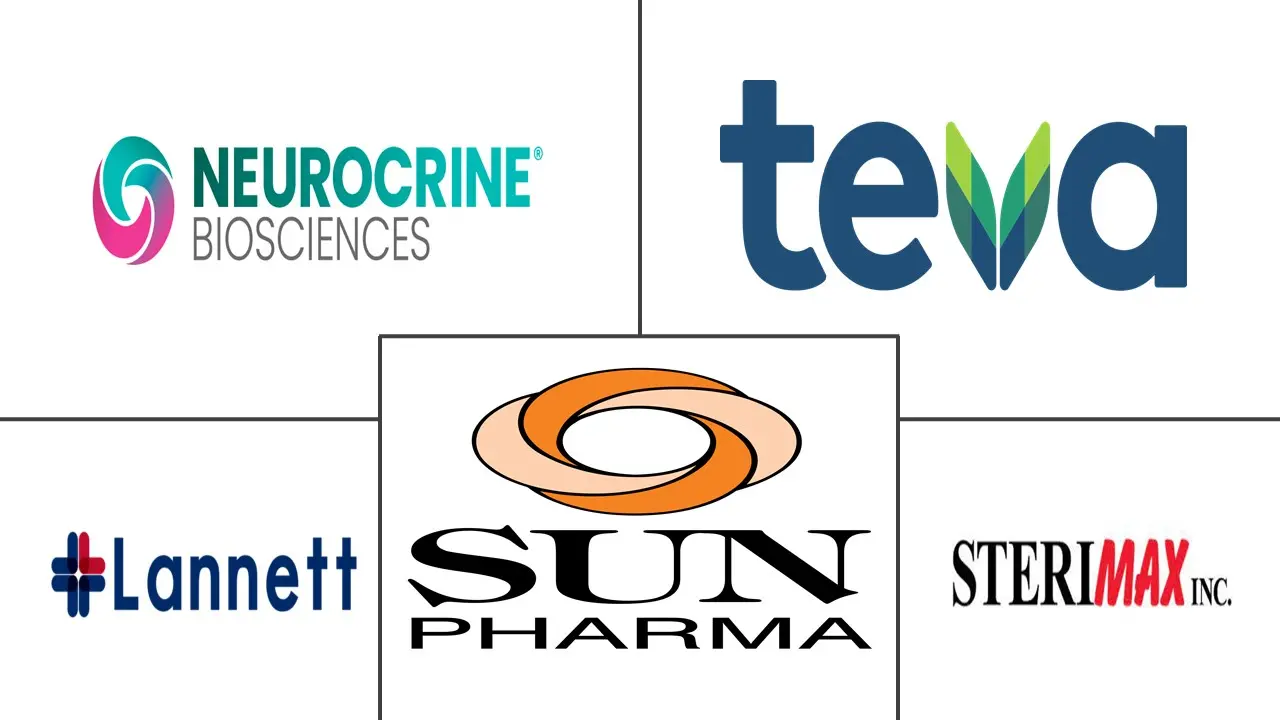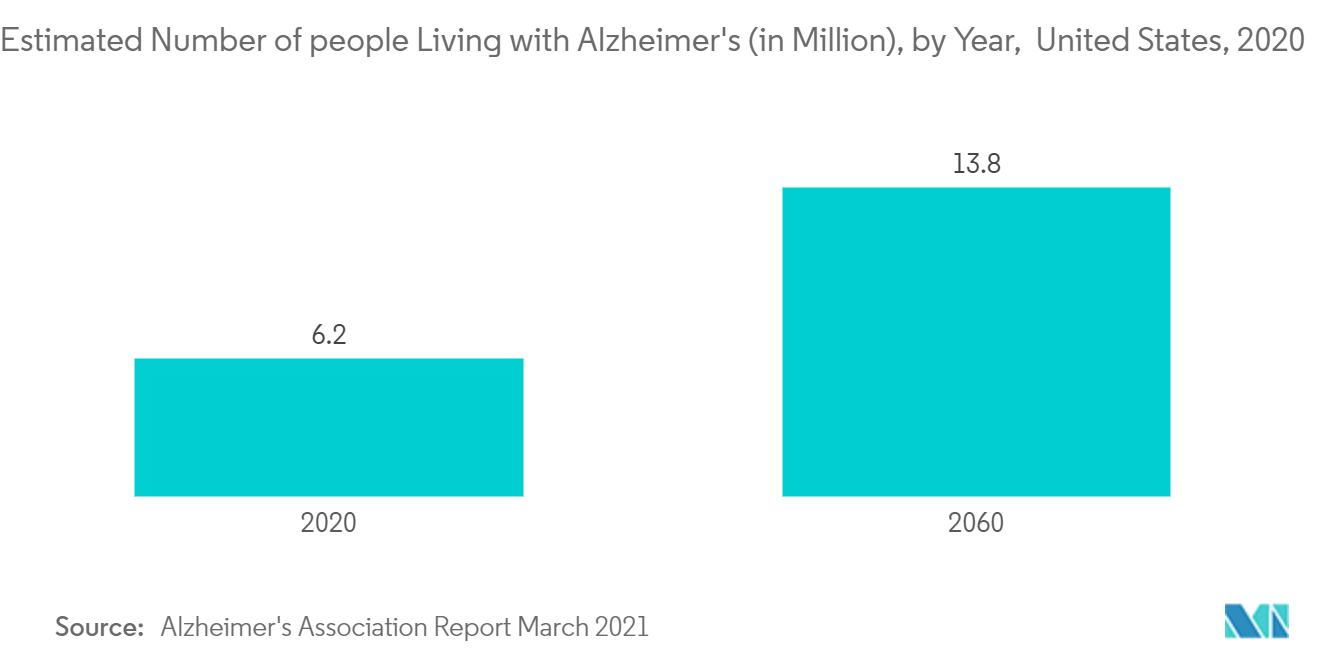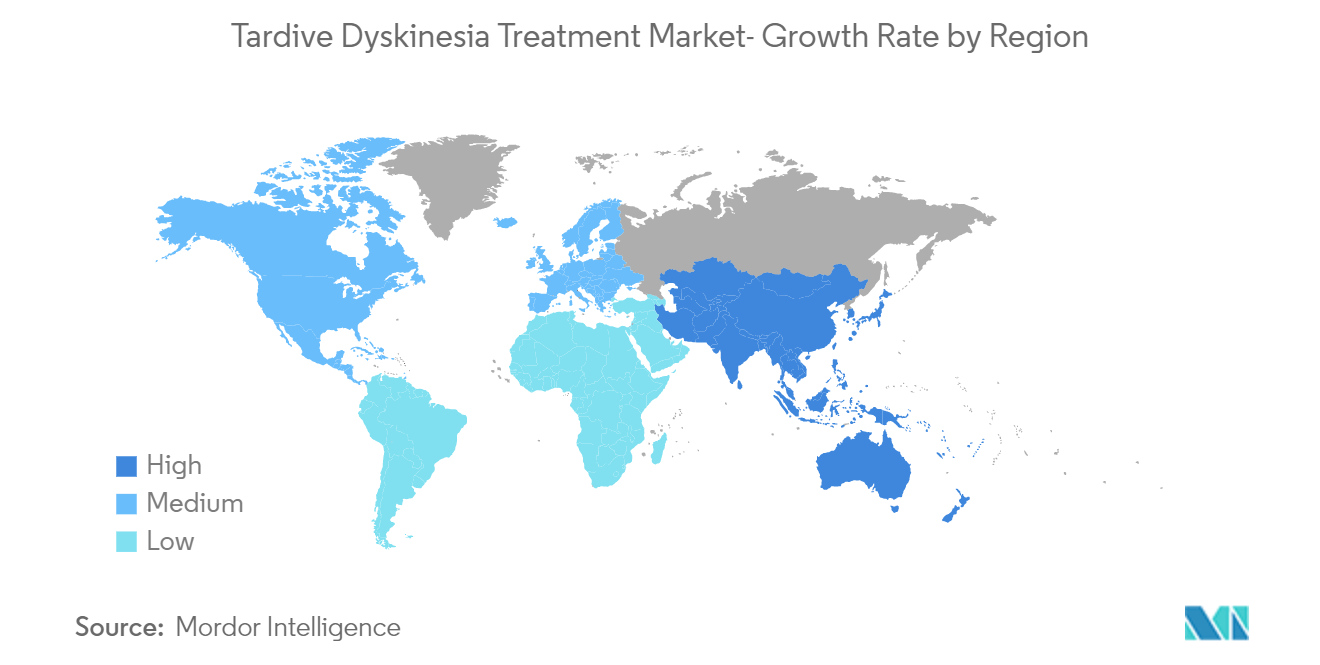Tardive Dyskinesia Treatment Market Analysis
The Global Tardive Dyskinesia Treatment Market is expected to register a CAGR of 4% during the forecast period.
COVID-19 has impacted the patient's access to healthcare facilities as the pandemic has forced the patients to wait for life-saving diagnostics as well as treatment procedures. To slow the spread of the virus, many hospitals have reduced or postponed non-emergency services, like screenings and diagnostic scans. According to the article published in Verywellhealth in October 2021, titled "What to Know About Tardive Dyskinesia and COVID-19," mental health disorders showed an association between the presence of any mental illness and an increased need for hospitalization or dying from COVID-19.
This is attributed to the growing number of Schizophrenia Patients and rising incidences of neurological disorders. With the long-term use of antipsychotic drugs by schizophrenia patients, the chances of patients suffering from tardive dyskinesia are high. Thus high risk is associated with a growing number of antipsychotic drugs leading to promoting the growth of the overall market. For instance, as per the World Health Organization Report in January 2022, Schizophrenia affects about 24 million individuals globally or 0.32%. Adults had a rate of 1 in 222 persons (0.45%).
Furthermore, the global prevalence of Parkinson's disease is estimated to be approximately 6.1 million globally, and the prevalence increases with age, reaching 1% to 3% in the population over 65 years of age, as per the research article 'Monoamine Oxidase-B Inhibitors for the Treatment of Parkinson's Disease: Past, Present, and Future' published in February 2022. In addition, the data updated by World Health Organization (WHO) in October 2021 shows that by 2030, 1 in 6 people in the world will be aged 60 years or over. Thus, rising in the prevalence of Alzheimer's disease is expected to rise in the pool population for tardive dyskinesia, thereby increasing the need for treatment, likely to boost the market.
Additionally, Also, the increasing prevalence of epilepsy in Mexico is also one of the factors driving the growth of the market studied. According to Anales Médicos de la Asociación Médica del Centro Médico ABC, in 2020, Epilepsy has a higher prevalence in developing countries and in Mexico. Prevalence of epilepsy in Mexico was reported with rates of 3.9 to 42.2 per 1,000 inhabitants. Thus increasing the prevalence of neurological diseases tardive dyskinesia population is expected to increase, thereby boosting the market studied.
However, side effects of drugs lack awareness about the disorder, and many undiagnosed cases may restrain the market to a certain extent.
Tardive Dyskinesia Treatment Market Trends
VMAT Inhibitor is Expected to Grow Faster Over the Forecast Period
The vesicular monoamine transporter type 2 (VMAT2) inhibitors are agents that cause a depletion of neuroactive peptides such as dopamine in nerve terminals and are used to treat chorea due to neurodegenerative diseases (such as Huntington chorea) or dyskinesias due to neuroleptic medications (tardive dyskinesia).
VMAT is expected to witness healthy growth in the future attributed to a growing number of neurological disorders and growing antipsychotic prescriptions. the global prevalence of Parkinson's disease is estimated to be approximately 6.1 million globally, and the prevalence increases with age, reaching 1% to 3% in the population over 65 years of age, as per the research article 'Monoamine Oxidase-B Inhibitors for the Treatment of Parkinson's Disease: Past, Present, and Future' published in February 2022. In addition, the data updated by World Health Organization (WHO) in October 2021 shows that by 2030, 1 in 6 people in the world will be aged 60 years or over. Tardive dyskinesia is associated with Parkinson's therapy, and it is expected that the prevalence of Parkinson's disease will rise over the forecast period, resulting in increased demand for the treatment option, and boosting segment growth.
Several product approvals in VMAT inhibitors are promoting the growth of the market. For instance, in May 2022, Neurocrine Biosciences presented new INGREZZA (valbenazine) data on tardive dyskinesia improvement and stability of psychiatric symptoms at the American Psychiatric Association Annual Meeting 2022. Such developments are expected to drive the tardive dyskinesia treatment market.
Several product approvals in VMAT inhibitors are promoting the growth of the market.
North America is Expected to Hold a Significant Share in the Market and Expected to do Same in the Forecast Period
North America is expected to hold a significant market share in the global tardive dyskinesia treatment market due to the increasing aging population, high prevalence of schizophrenia, increasing awareness, increasing healthcare expenditure, and the presence of well-established healthcare infrastructure. As the growing aging population will be leading to many diseases related to neurological for which this population has to take antipsychiatric drugs. Thus these populations are more prone to develop these diseases. According to the National Alliance on Mental Health in May 2021, the prevalence of schizophrenia in the United States is in the range of 0.25% to 0.64%, or 1.5 million people per year.
Additionally, the data provided in the article 'The Financial Burden from Parkinson's Exacts a High Cost' published in September 2021 shows that in the United States, an estimated 1 million people have Parkinson's disease, and more people are diagnosed with it every year, among which the prevalence is more among people of age 65 years or older. As per the source above, the prevalence of PD also has increased among people younger than 65. Additionally, the data updated by Parkinson Canada's National Roundtable Report in March 2022 shows that in Canada, more than 100,000 people have PD, and this number will grow in the coming days reaching 50 new diagnoses every day within 10 years. Thus, the high burden of the disease among the target population of countries across North America is anticipated to create demand for the development of drugs for treatment. Thereby, driving the market growth.
Moreover, targeted patient pools such as populations treated with schizophrenia and bipolar disorder in this region are also associated with this disorder, hence promoting the growth of the tardive dyskinesia treatment market in this region.
Tardive Dyskinesia Treatment Industry Overview
The Tardive Dyskinesia Treatment Market is moderately competitive and consists of several major players. Some of the companies which are currently dominating the market are Teva Pharmaceutical Industries Ltd, Neurocrine Biosciences, Inc, Sun Pharmaceutical Industries Ltd, SteriMax Inc., Lannett Co Inc, Sanis, and Allergan.
Tardive Dyskinesia Treatment Market Leaders
-
Neurocrine Biosciences, Inc
-
Teva Pharmaceutical Industries Ltd
-
Sun Pharmaceutical Industries Ltd
-
SteriMax Inc.
-
Lannett Co Inc
- *Disclaimer: Major Players sorted in no particular order
Tardive Dyskinesia Treatment Market News
- In May 2022, Neurocrine Biosciences presented new INGREZZA (valbenazine) data on tardive dyskinesia improvement and stability of psychiatric symptoms at the American Psychiatric Association Annual Meeting 2022
- In August 2021, Teva Pharmaceuticals, a subsidiary of Teva Pharmaceutical Industries Ltd. in the United States, released the results of a post hoc analysis of a long-term, three-year open-label extension (OLE) study examining efficacy and safety endpoints for the use of AUSTEDO (Deutetrabenazine) tablets in younger (55 years) and older (55 years) patients with tardive dyskinesia (TD).
Tardive Dyskinesia Treatment Industry Segmentation
As per the Scope, the Tardive Dyskinesia treatment market deals with the diagnosis of involuntary movement in the jaw, lips, and tongue. The Tardive Dyskinesia Treatment Market is segmented By Disorder (Bradykinesias, Hyperkinesias), Drug Class (Dopamine-Depleting Medications, VMAT2 inhibitors, GABA Receptor agonist medications, Anticholinergic Medications), End User (Hospitals, Clinics, Others), and Geography (North America, Europe, Asia-Pacific, Middle East & Africa, and South America). The market report also covers the estimated market sizes and trends for 17 different countries across major regions globally. The report offers the value (in USD million) for the above segments.
| By Disorder | Bradykinesia | ||
| Hyperkinesia | |||
| By Drug Class | Dopamine-Depleting Medications | ||
| VMAT2 Inhibitors | |||
| GABA Receptor Agonist Medications | |||
| Anticholinergic Medications Trihexyphenidyl | |||
| By End User | Hospitals | ||
| Clinical | |||
| Others | |||
| Geography | North America | United States | |
| Canada | |||
| Mexico | |||
| Europe | Germany | ||
| United Kingdom | |||
| France | |||
| Italy | |||
| Spain | |||
| Rest of Europe | |||
| Asia-Pacific | China | ||
| Japan | |||
| India | |||
| Australia | |||
| South Korea | |||
| Rest of Asia-Pacific | |||
| Rest of the World | |||
Tardive Dyskinesia Treatment Market Research FAQs
What is the current Global Tardive Dyskinesia Treatment Market size?
The Global Tardive Dyskinesia Treatment Market is projected to register a CAGR of 4% during the forecast period (2025-2030)
Who are the key players in Global Tardive Dyskinesia Treatment Market?
Neurocrine Biosciences, Inc, Teva Pharmaceutical Industries Ltd, Sun Pharmaceutical Industries Ltd, SteriMax Inc. and Lannett Co Inc are the major companies operating in the Global Tardive Dyskinesia Treatment Market.
Which is the fastest growing region in Global Tardive Dyskinesia Treatment Market?
Asia Pacific is estimated to grow at the highest CAGR over the forecast period (2025-2030).
Which region has the biggest share in Global Tardive Dyskinesia Treatment Market?
In 2025, the North America accounts for the largest market share in Global Tardive Dyskinesia Treatment Market.
What years does this Global Tardive Dyskinesia Treatment Market cover?
The report covers the Global Tardive Dyskinesia Treatment Market historical market size for years: 2019, 2020, 2021, 2022, 2023 and 2024. The report also forecasts the Global Tardive Dyskinesia Treatment Market size for years: 2025, 2026, 2027, 2028, 2029 and 2030.
Our Best Selling Reports
Tardive Dyskinesia Therapeutics Industry Report
Statistics for the 2025 Global Tardive Dyskinesia Treatment market share, size and revenue growth rate, created by Mordor Intelligence™ Industry Reports. Global Tardive Dyskinesia Treatment analysis includes a market forecast outlook for 2025 to 2030 and historical overview. Get a sample of this industry analysis as a free report PDF download.







